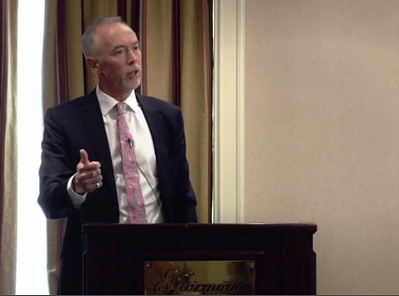There’s no question that massive infrastructure will need to be built in order to mine the large chromite deposits in the Ring of Fire, says Noront Resources (TSXV: NOT) president and CEO Alan Coutts.
However, Coutts sees the big infrastructure needs — such as Mushkegowuk Tribal Council’s recent announcement regarding a First Nations-led plan to develop a rail, power and seaport in James Bay (see page 1) — as a project for the long term.
“The needs that Mushkegowuk are talking about are the long-term infrastructure needs, if there is to be large-scale chromite mining in the Ring of Fire,” Coutts said. “In my opinion, that’s at least a decade off — there’s nobody advancing a large-scale chromite project now, and certainly the ability to permit such a project with big waste-rock piles, big tailings storage areas and large water-treatment needs, because of the water coming into pits — it’s a long way off.”
Cliffs Natural Resources (NYSE: CLF) suspended work on its Black Thor open-pit chromite project in the Ring of Fire late last year, leaving junior Noront as the nearest-term potential producer in the remote region of Ontario.
Noront also has Blackbird, a high-quality chromite deposit in the area, but instead it’s focusing on its Eagle’s Nest nickel–copper–platinum group metals project — a high-grade deposit with much more modest infrastructure needs.
Coutts sees Eagle’s Nest as part of an initial, smaller-scale phase of development in the Ring of Fire.
“There’s the first decade where you have a relatively small infrastructure that gets development up in earnest and allows people to participate and get trained, and feel confident about how things are progressing,” Coutts says.
“Then once you’ve got that established, you can start thinking about permitting a bigger-scale, more challenging deposit like a chromite deposit, which would need a vastly different infrastructure.
“And hopefully by that time, the local people have a good feeling about mining and how it’s unfolding, and how it can manage the environment — and then you can have that discussion.”
Coutts, who has mused about buying Cliffs’ projects for the right price, notes that Eagle’s Nest will be a low-impact, benign development. The mine tailings at the underground project would be placed underground, and all of the mine’s processed water would be recycled for reuse, rather than being treated and released into the environment.
“We think it’s a permittable project,” Coutts says. “So we think that’s the best first step in this region to get people involved and confident, and to see whether or not mining companies can live up to their promises about how they manage the environment, and how they involve First Nations.”
Noront would only need to truck 150,000 to 200,000 tonnes of concentrate a year from the mine, which has an 11-year mine life, as opposed to the millions of tonnes of material that would have to be trucked from a large-scale chromite mine. In terms of infrastructure, the junior would just need a road: it envisions a route going north from Pickle Lake and crossing several Matawa communities on the way east to the Ring of Fire.
However, Noront couldn’t pay the estimated $500-million cost by itself. In a 2012 feasibility study, the company assumed it would pay $10 million a year in road tolls or fees.
Unlike the north–south industrial road Cliffs proposed when it was advancing its Black Thor project, this road would be accessible to local communities.
As for working with the Mushkegowuk over the longer term on their plan, Coutts says the company is open.
“Our preference is always to deal first with our friends in Matawa because they are the traditional lands of the Matawa people,” he said.
“But if it’s an idea that a lot of people can support and it makes sense, certainly we’ll explore it. But as I said, I think those kinds of grandiose infrastructure plans are a little bit down the road.”
The Eagle’s Nest feasibility showed that a US$609-million capital investment would yield a US$543-million net present value after taxes, and a 28% internal rate of return at an 8% discount rate. The study assumed metals prices of US$9.43 per lb. nickel, US$3.60 per lb. copper, US$1,600 per oz. platinum, US$599 per oz. palladium and US$1,415 per oz. gold.
Eagle’s Nest holds proven and probable reserves of 11 million tonnes grading 1.68% nickel, 0.87% copper, 0.89 gram platinum per tonne, 3.09 grams palladium and 0.18 gram gold.
Coutts joined Noront last October, after spending most of his career with base-metal majors that included Falconbridge and Xstrata.
He says two things attracted him to Noront.
One was his experience working for Falconbridge at the Raglan nickel mine in northern Quebec, which involved building a mine in a remote, arctic environment, and bringing the Inuit on board as partners.
“It was an experience I really liked, to be honest — I found it worthwhile and fulfilling, and I think we as Falconbridge were groundbreaking. We were creative and innovative, and we came up with the Raglan Agreement [with the Inuit].”
The other was his knowledge of nickel projects, most recently as managing director of Xstrata Nickel Australasia.
“I spent a lot of time in the nickel space over the years and I can identify a great project when I see one.”
Noront is in the environmental permitting stage at Eagle’s Nest. The company completed a harmonized environmental assessment (EA) and environmental impact statement (EIS) in December. While the federal government has been working on the EIS, the province has lagged on the EA. The company has asked the Ontario government to approve the terms of reference and start the EA review before year-end.
Noront shares recently traded at 49¢ in a 52-week range of 15¢ to 70¢. The company has 231.8 million shares outstanding.


Be the first to comment on "Start small in the Ring of Fire, Noront CEO says"